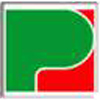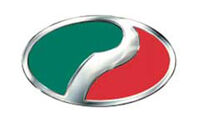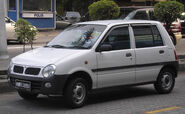| Type | Limited company |
|---|---|
| Founded | 1993 |
| Headquarters | Serendah, Selangor, Malaysia. |
| Industry | Automotive |
| Products |
Supermini Kei car |
| Employees | 10,000 |
| Website | Perodua.com.my |
The PERusahaan Otomobil KeDUA Sendirian Berhad (English: Second Automobile Manufacturer Private Limited), usually abbreviated to Perodua Cars (pronounced /pəˈrɒdjuː.ə/), is Malaysia's second largest automobile manufacturer after Proton. It was established in 1992 and launched their first car, the Perodua Kancil in August 1994.[1] The shareholders of Perodua are UMW Corporation Sdn Bhd with 38% stake, Daihatsu Motor Co. Ltd. (20%), MBM Resources Bhd (20%), PNB Equity Resources Corporation Sdn Bhd (10%), Mitsui & Co. Ltd (7%) and Daihatsu (Malaysia) Sdn Bhd (5%).
Perodua mainly produces minicars and superminis and therefore does not actually directly compete with Proton. They do not actually produce any in house designs or engineering for their main components (i.e. engine, transmission). Historically, Perodua cars are badge engineered from existing Daihatsu designs. Daihatsu originally held a 20% stake in Perodua, increasing this to 25% in 2001 and then to 35%.[1] In 2004, the Toyota Avanza started being assembled by Perodua in their factory in Rawang for the Malaysian market.
Exports[]
In the United Kingdom their cars are sold by some Proton dealers who wish to attract customers seeking an even smaller and cheaper alternative to the Proton range. Sales numbers in the UK are extremely small however, and in 2008 Perodua sold only 624 cars (down from 914 in 2002) and insignificant compared to 2008 figures of 28,036 for Hyundai, 29,397 for SEAT. Sales were up slightly in 2009 (to 650) and then to 761 in 2010,[2] mainly due to the success of the new Perodua Myvi.[3] Besides the UK and Singapore, Perodua also exports their cars to Mauritius, Brunei, Sri Lanka, Cyprus, Malta, Egypt, Nigeria, Senegal, Lebanon, Qatar, Saudi Arabia, Syria, Nepal and Fiji in small numbers by local dealers.
The Perodua logo[]

The original Perodua logo
Perodua organised a logo competition in 1997 to find a new corporate logo, to be launched together with their upcoming model, tentatively known as the X555. The competition was won by Johnson Ng Weng Kuan, an architecture student from Universiti Teknologi Malaysia. Perodua officially launched the new corporate logo on 24 August 1998 when they launched Malaysia's first 4x4 vehicle, the Perodua Kembara.
The new logo maintains the 'P' and '2' and the colours of the old, squarish logo, but has been stylised further to become elliptical, which is more fluid and dynamic. The green colour represents social responsibility to the environment and the community, while the red colour symbolises the development of competent workforce and resilience in meeting challenges in the globalised world. However, the emblems mounted on the company's latest cars have black in place the green and red areas, with the chrome relief maintained as it was.
Corporate information[]
As compared to Proton, Perodua has been quite successful in its business ventures. Its cars are very popular among Malaysians, such as the recently introduced Perodua Myvi, which sold 80,327 units in 2006, outselling its rivals best selling car, the Proton Wira, which only sold 28,886 units in Malaysia. In 2006 and 2007, Perodua became the best selling car company in Malaysia.
Perodua is set to become the largest compact carmaker in South-East Asia. It currently has capacity to make 200,000 cars annually. By July 2007, it is expanding to 240,000 per year. In October 2005, it had produced a cumulative total of 1 million cars.[4]
List of models[]
- Perodua Kancil (Perodua Nippa, 1994–2009)
- Perodua Rusa (1996–1998)
- Perodua Kembara (1998–2008)
- Perodua Kenari (2000–2008)
- Perodua Kelisa (2001–2007)
- Perodua MyVi (2005–present)
- Perodua Viva (2007–present)
- Perodua Nautica (2008–2010)
- Perodua Alza (2009–present)
Gallery[]
See also[]
- List of automobile manufacturers
- Proton (company), another Malaysian car manufacturer.
References[]
| This page uses some content from Wikipedia. The original article was at Perodua. The list of authors can be seen in the page history. As with Tractor & Construction Plant Wiki, the text of Wikipedia is available under the Creative Commons by Attribution License and/or GNU Free Documentation License. Please check page history for when the original article was copied to Wikia |
- ↑ 1.0 1.1 (2006) World of Cars 2006·2007. Warsaw, Poland: Media Connection Sp. z o.o., 203.
- ↑ "UK Auto Sales By Brand - 2010 Year End". Good Car Bad Car (2011-01-10).
- ↑ "Perodua Maintains Growth as Market Slows (press release)". Perodua UK (2010-08-18).
- ↑ "Perodua set to be largest compact car maker in region". Daily Express. Retrieved on 2009-05-10.
External links[]
| ||||||||











